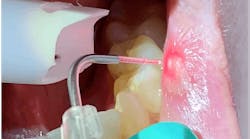Anytime we do something new, we face a learning curve. Starting in clinical dental hygiene is no different, and it can be very challenging to say the least. I can still recall my first few months, and I felt in over my head. I lacked confidence in my skills, felt ill-prepared to manage challenging patient personalities, and lived in what felt like an endless cycle of self-doubt. I was also in pain at the end of the day.
Through the years, I’ve had many former-students-turned-new-graduates reach out to share those same feelings. What none of us realize when we’re going through this is that every new graduate feels the same growing pains. Here are three common mistakes, and what grads can do differently when navigating their new career in dental hygiene.
More student/new grad articles
5 ways to cope with hygiene school when you're struggling
4 ways to “Wow!” as a new dental hygiene grad
Mistake: Self-doubt
The fix: Acknowledge that you’re exactly where you’re supposed to be in your learning and development. We graduated from dental hygiene school with a lot of knowledge. We spent countless hours learning both didactic and clinical material. We gained experience in direct patient care and that care became more complex with each semester. By the time we got out into the world to practice, we’d graduated from an intensive program, met the required patient care experiences, and passed board exams. This should have helped us enter the professional world as experts, right?
That’s not always the case. Even top graduates begin practice at a point of minimal clinical competency. We’re qualified and prepared to treat patients, but the ladder to clinical expertise and mastery is based on continued experience.1 You may have graduated, but you’re still learning. If you’re doing it correctly, you’ll learn and grow throughout your career. This concept is discussed in detail in an article titled “The ladder to clinical experience and expertise.” 2
Remind yourself this is perfectly normal. Learn from every experience and refine and improve your skills. Improve your time management and find ways to prepare for appointments efficiently. Have a solid network of peers and mentors, stay current, and participate in continuing education. It’s important to ask questions, look for patterns, and develop that critical thinking muscle. Objectively observe areas that went well. Similarly, assess challenges and areas that need further development. Lastly, remember that even with as much as you’re learning, you still know a lot. Your patients can learn so much from you and can greatly benefit from the care you provide. Trust the process and show yourself some compassion.
Mistake: The “no one is watching me” syndrome
(aka, ergonomics schmergonomics)The fix: Develop good ergonomic habits from the start. Our career can take a toll on the body. The habits you form today can make or break your career longevity and satisfaction.
I remember well my early days in practice. Without an instructor’s watchful eye, ergonomics was the first thing I sacrificed in my effort to make it through an appointment. My positioning and technique became more about trying to get it done than it was about proper body mechanics and optimal instrumentation stroke. I hadn’t quite mastered indirect vision so instead of practicing, I contorted myself to see. The combination of nerves and lack of self-focus resulted in my hands aching at the end of the day, along with my neck, back, and wrist.
The high prevalence of musculoskeletal disorders (MSDs) among dental professionals is well documented. One study reported the one-year prevalence rate of MSDs in dental hygienists ranges from 60% to 96%, with pain frequently presenting in the neck, shoulder, wrist, hand, and back.3 The single greatest cause of hand injuries in dental hygienists is excessive pinch force between the thumb and index finger.4 The work comes with static posture, twisting, and precise movements of the hand, meaning risk is inherent in the profession.
When we add less-than-optimal work practices, the risks increase dramatically. Another study confirms that risk factors are multifactorial and dental hygienists should be aware of the factors that can be prevented.5 Disease is cumulative over time and progression may result in extensive medical treatment or an inability to practice.
To continue to practice pain-free and for as long as you would like to practice, you need to implement consistent and solid ergonomics principles today. Some key areas to focus on are:
- When you’re working, check for neutral positioning and grasp throughout the appointment.
- If you’re struggling to see in some areas, review the correct seating positions for each area of the mouth. Chances are your patient is seated too high.
- Take the time to master indirect vision so you can see each area while also keeping your back and neck straight.
- Use ergonomic handled sharp instruments that are adapted correctly to minimize hand pressure and fatigue. (I recommend students do not sell their school instruments. These can come in handy for practicing skills at home, as well as to bring with you to work assignments that may have less than optimal instruments until a permanent solution is reached.)
- Use a strong and stable fulcrum and lighten up your grasp.
- Wear the correct size gloves. Gloves that are too small pull across your palm near the thumb and cause pain.
- Consider the advantages of ergonomic aids such as loupes, saddle seating, and the like.
- Take care of yourself: exercise, stay hydrated, stretch throughout the day, and be mindful of the number of hours and type of schedule you work.
Mistake: Failure to fact check
(When we’re new, we may blindly believe what others tell us.)Fix: You’ll learn from colleagues and mentors, and it’s important to listen. Do not, however, forget your responsibility to know the scope of practice in your state, understand basic employment laws and rights, and know the standard of care.
Solid information from credible sources is available at your fingertips. For questions about employment, visit the federal and state department of labor websites. Similarly, state Board of Registration in dentistry will list on their website the duties you’re allowed to perform. Bad information can surround us and when we make decisions without doing our homework, we are responsible. Our schooling taught us how to seek out and identify credible resources. Use that skill throughout your career.
Stepping into the world of practice from school can be overwhelming. Where you are right now is an extension of your formal schooling. With time, patience, openness, and the desire to learn and grow, you’ll gain speed and confidence, and you’ll climb the ladder toward clinical mastery. Enjoy the view on your way up. You worked hard to get here!
References
- Dreyfus SE. The five-stage model of adult skill acquisition. Bull Sci Tech Soc. 2004;24(3):177-181. doi:10.1177/0270467604264992
- Whiteley J. The ladder to clinical experience and expertise. February 24, 2021.
- https://www.dentistryiq.com/dental-hygiene/career-development/article/14198251/the-ladder-to-clinical-experience-and-expertise
- Johnson CR, Kanji Z. The impact of occupation-related musculoskeletal disorders on dental hygienists. Can J Dent Hyg. 2016;50(2):72-79.
- Sanders MJ, Turcotte CA. Ergonomic strategies for dental professionals. Work. 1997;8(1):55-72. doi:10.3233/WOR-1997-8107
- Lalumandier JA, McPhee SD, Riddle S, Shulman JD, Daigle WW. Carpal tunnel syndrome: effect on Army dental personnel. Mil Med. 2000;165(5):372-378.







